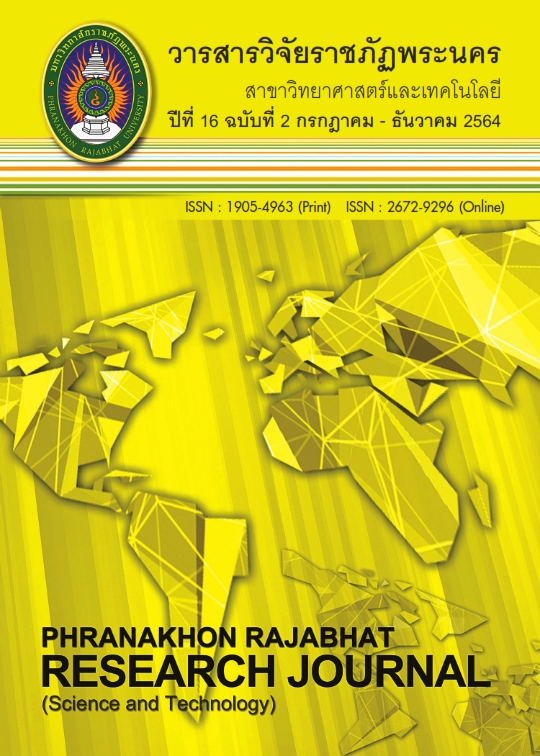IMPACT OF PM2.5 ON BUILDING HYGIENE, A CASE STUDY OF CHANTHABURI NATIONAL ARCHIVES
Keywords:
PM2.5, building hygiene, archived building, residential building, public buildingAbstract
The purpose of this research was to analyze the concentration and compare the average of PM2.5 in the open system room, closed system room and outside the building at the National Archives building, Chanthaburi. It is a cross-sectional study research and purposive air sampling, including 3 groups, open air room, closed or air-condition room and outside the building at the entrance. Each group was sampling 3 points, each point measured 1 hour average for a total of 8 hours per point for a total of 72 samples, with the DUSTTRAK DRX Aerosol Monitor. The data were compared with the Indoor Air Quality Standards recommended by the Department of Health. The statistics used for data analysis were mean ( ), standard deviation (S.D.), F-test, Kruskal-Wallis test and Mann-Whitney U test. The results showed that the concentration of PM2.5 was in the range of 28 - 82 µg/m3 and averaged in the range of 28.4 - 73.5 µg/m3. The room that PM2.5 was higher than the standard are the Document Valuation and Assessment Room, Film Valuation and Assessment Room, Archives Office Room (Administration Room) and Document Center Room. The average of PM2.5 in open air room group was significantly higher than the closed room group (p < .05). The average of PM2.5 in open air room group was not significantly different from those outside the building (p > .05). The average of PM2.5 in closed room group was significantly lower than the outside the building (p < .05). Suggestions for improvement according to the sanitary principles to be hygienic by closing doors, windows, gaps or leaks. It is a simple and low-cost method of improving building hygiene, suitable for residential and public buildings for good hygiene and safety for residents.
References
Bureau of Environmental Health. (2016). Indoor air quality assessment operation manual for staff. Nonthaburi: Department of Health, Ministry of Public Health.
Department of Disease Control. (2019). Guidelines for surveillance of health impacts from particulate matter up to 2.5 microns (PM2.5). Retrieved from https://pher.moph.go.th/wordpress/wp-content/uploads/2019/11/ /pdf [2021, 1 Apr.]
Kanidta, C., & Natphasuth, P. (2020). Emission source impact and problem solving and management on PM 2.5 in the northern part of Thailand. Journal of the Association of Researchers, 25(1), 461-474.
Katika, S., Kannalinya, B., Sirsawaranys, S., & Yuparat, K. (2016). Exploration of airborne fungi in research building, Faculty of Science Ubon Ratchathani University. Retrieved from http://repository.rmutr.ac.th/bitstream/handle/123456789/273/50.BInno2016-1005-86.pdf?sequence=1&isAllowed=y [2018, 12 Nov.]
Mašková, L., Smolík, J., & Vodicka, P. (2015). Characterisation of particulate matter in different types of archives. Atmospheric Environment, 107, 217-224.
Ministry of Public Health. (2021). Health data center (HDC). Retrieved from https://hdcservice. moph.go.th/hdc/reports/report.php?source=pformated/format1.php&cat_id=9c647c1f31ac73f4396c2cf987e7448a&id=297c1cb035778f7b49357693e6867e6c [2021, 24 Jun.]
Office of the Royal Society. (2011). Dictionary of the Royal Institute of Thailand 2011. Retrieved from https://dictionary.orst.go.th [2021, 1 Apr.]
Provincial Office of Natural Resources and Environment Chanthaburi. (2021). PM2.5 & hotspot NEWS. Retrieved from http://chanthaburi.mnre.go.th/th/news/more/140/page/1 [2021, 24 Jun.]
Royal Thai Government Gazette. (2010). National Environment Board Announcement No. 36 (2010) subject: Standards for particulate matter with a size of not more than 2.5 microns in the ambient air. Retrieved from http://www.ratchakitcha.soc.go.th/DATA/PDF/2553/E/037/61.PDF [2021, 1 Apr.]
Royal Thai Government Gazette. (2019). Notification of the Pollution Control Department subject: Measuring instruments and methods for measuring the average value of gases or particulates in the ambient air, other systems or other methods approved by the Pollution Control Department. Retrieved from http://www.ratchakitcha.soc.go.th/DATA/PDF/2562/E/259/T_0037.PDF [2021, 1 Apr.]
Sumontarikan, M., Onanong, W., Benjamas, T., Chavinthorn, M., Wirakorn, T., Sitthiphan, C., & Sukon, K. (2018). Occupational health hazards in the national archive and its branches –archivists and scientists’ attitude. Safety and Environment Review E-Journal, 1(1), 28-33.
World Health Organization. (2016). Air pollution and health. Retrieved from https://www.who.int/docs/default-source/searo/wsh-och-searo/01-th-air-pollution-get-fold-leaflet-web.pdf?sfvrsn=1b7437f8_2 [2021, 1 Apr.]
Worrawut, K. (2017). Effects of particulate matter (PM10) from road traffic on students’s health: case study of Phra Pathom Witthayalai School Mueang District, Nakhon Pathom Province. (Master degree). Silpakorn University, Mueang District, Nakhon Pathom Province.
Downloads
Published
Issue
Section
License
โปรดกรอกเอกสารและลงนาม "หนังสือรับรองให้ตีพิมพ์บทความในวารสารวิจัยมหาวิทยาลัยราชภัฏพระนคร สาขาวิทยาศาสตร์และเทคโนโลยี" ก่อนการตีพิมพ์




